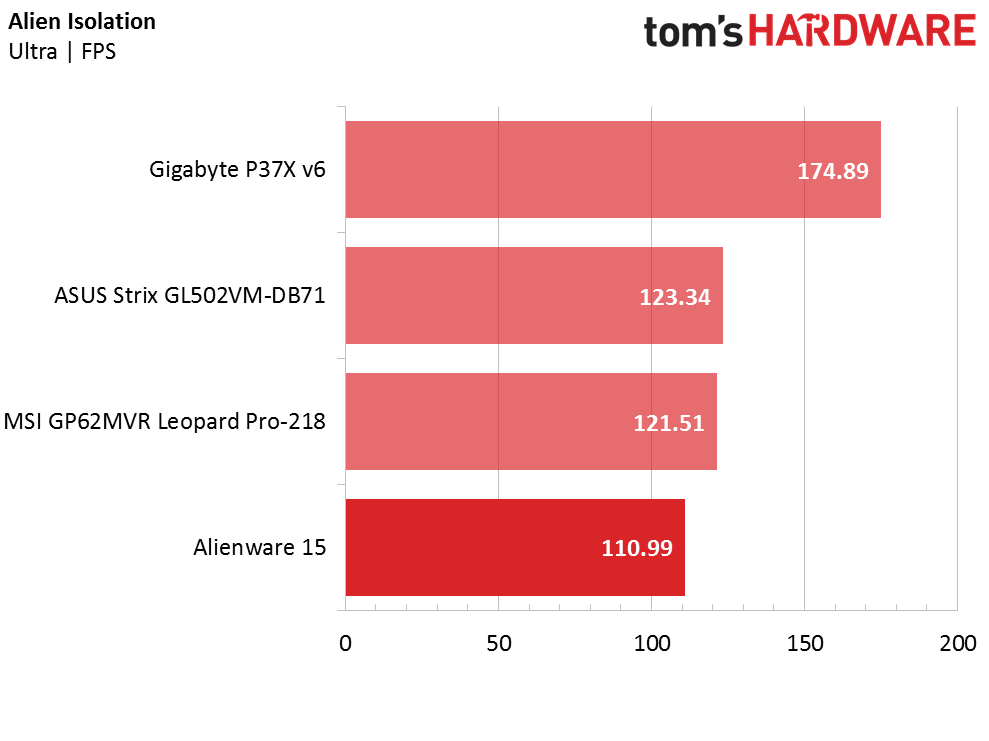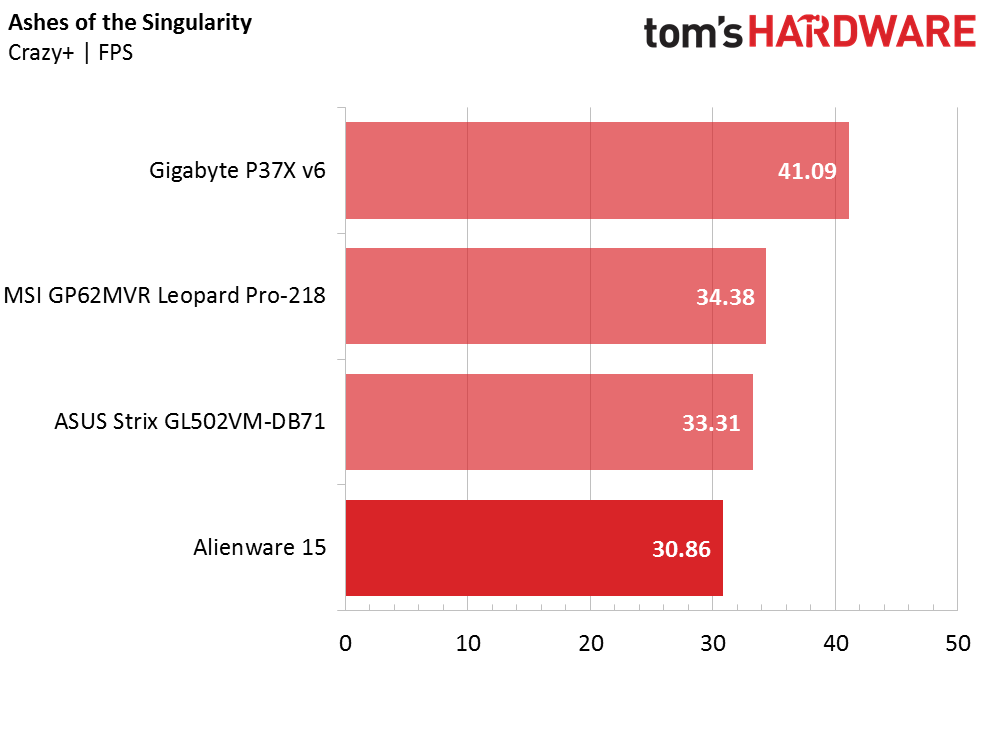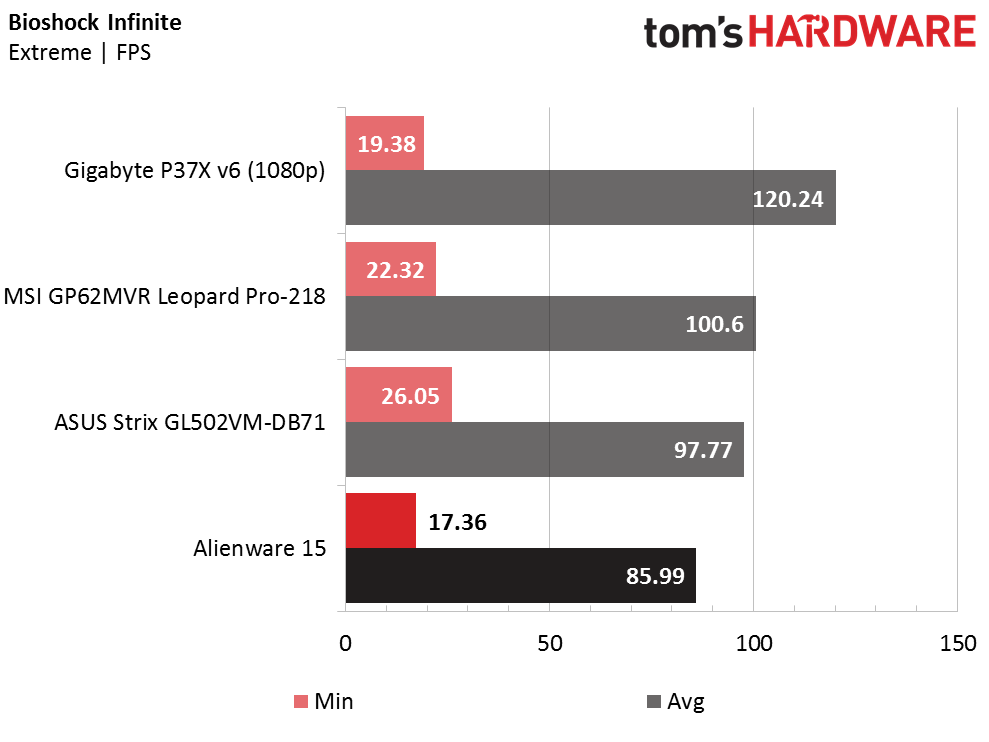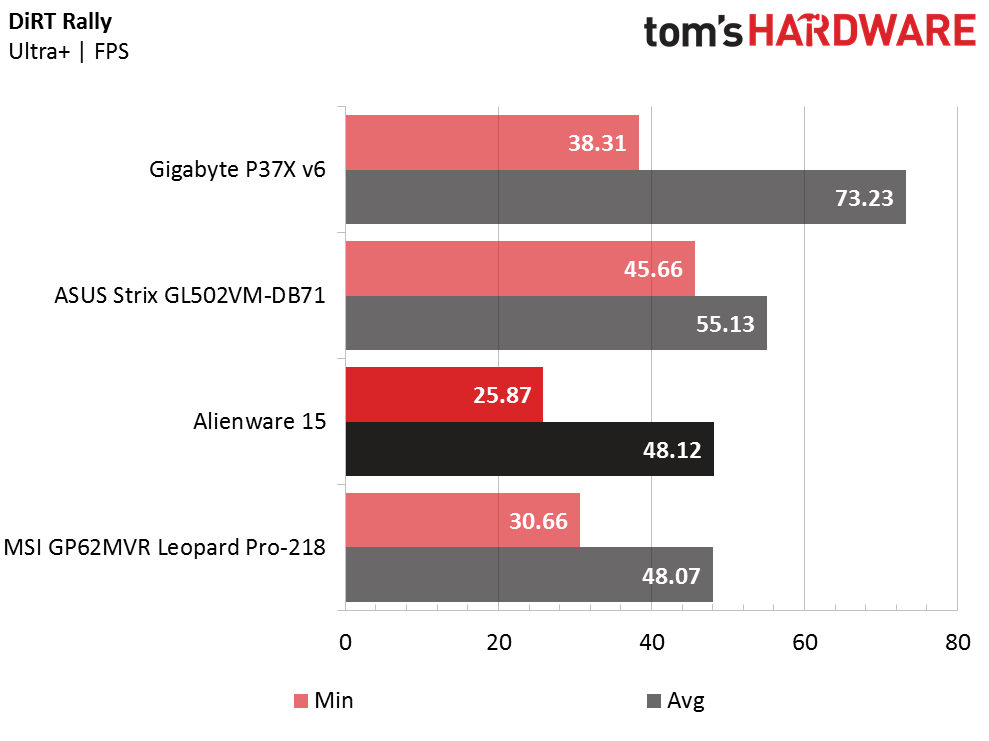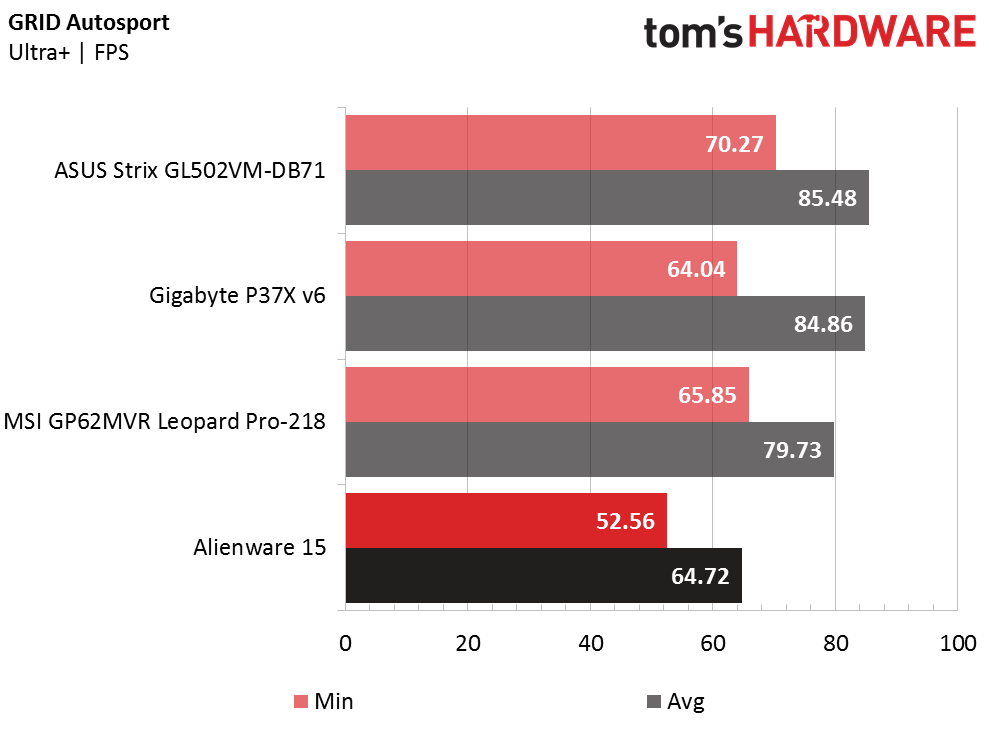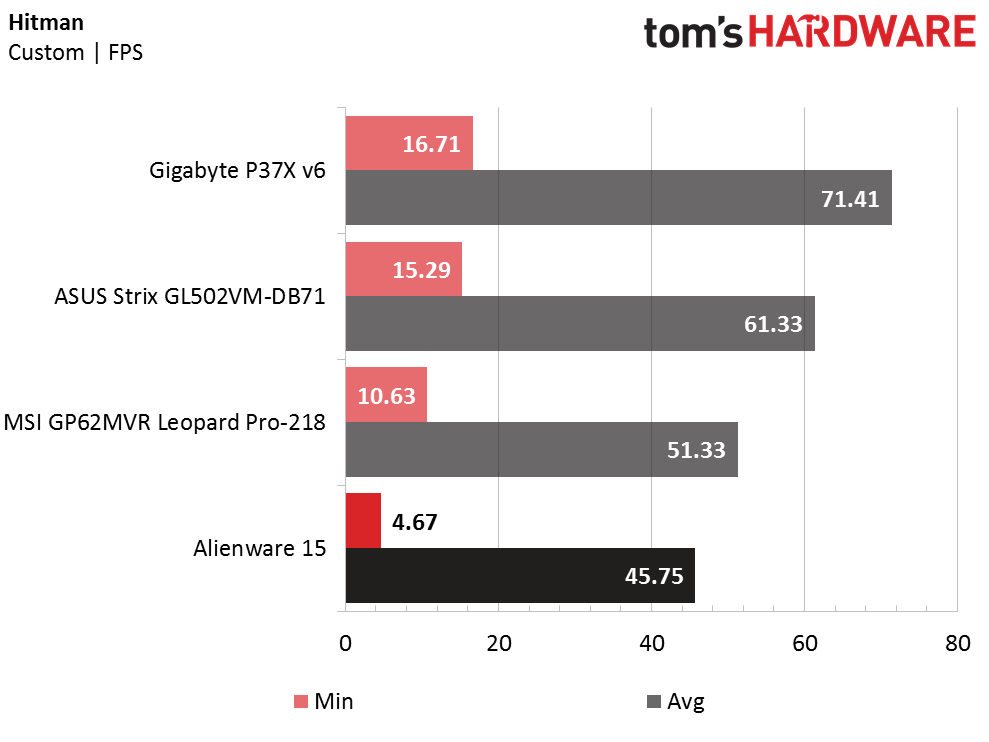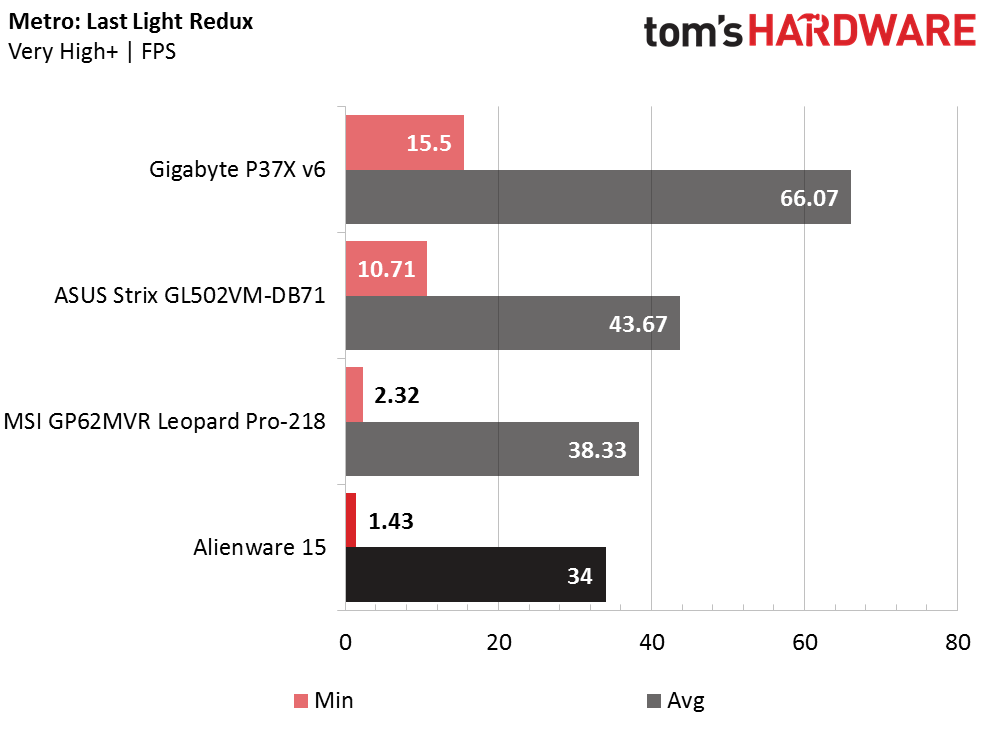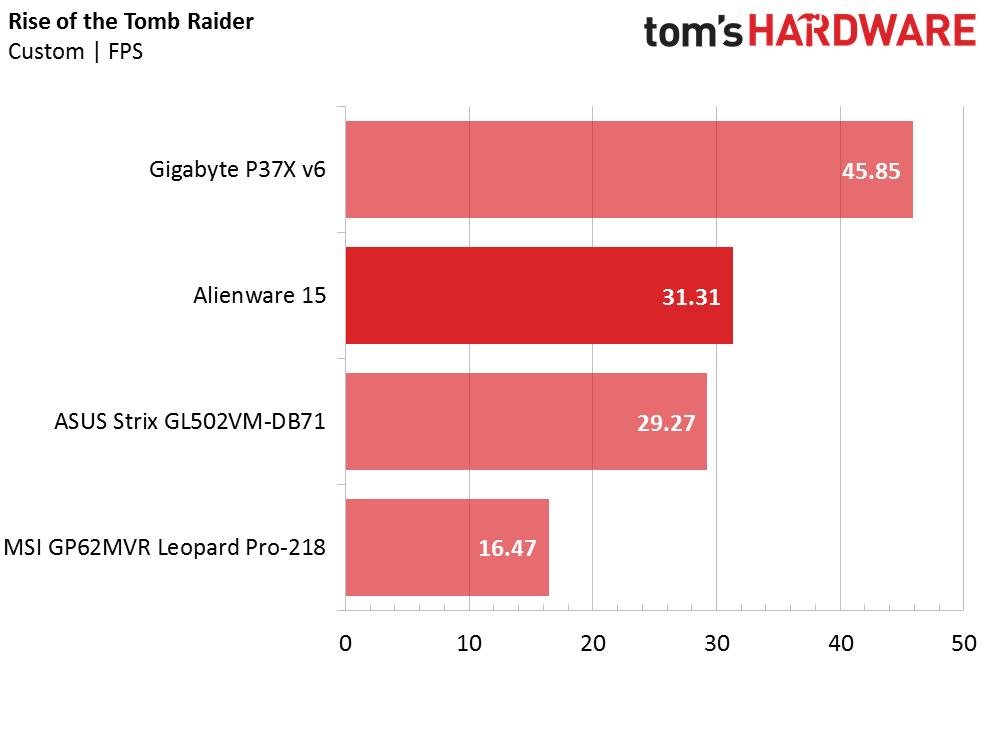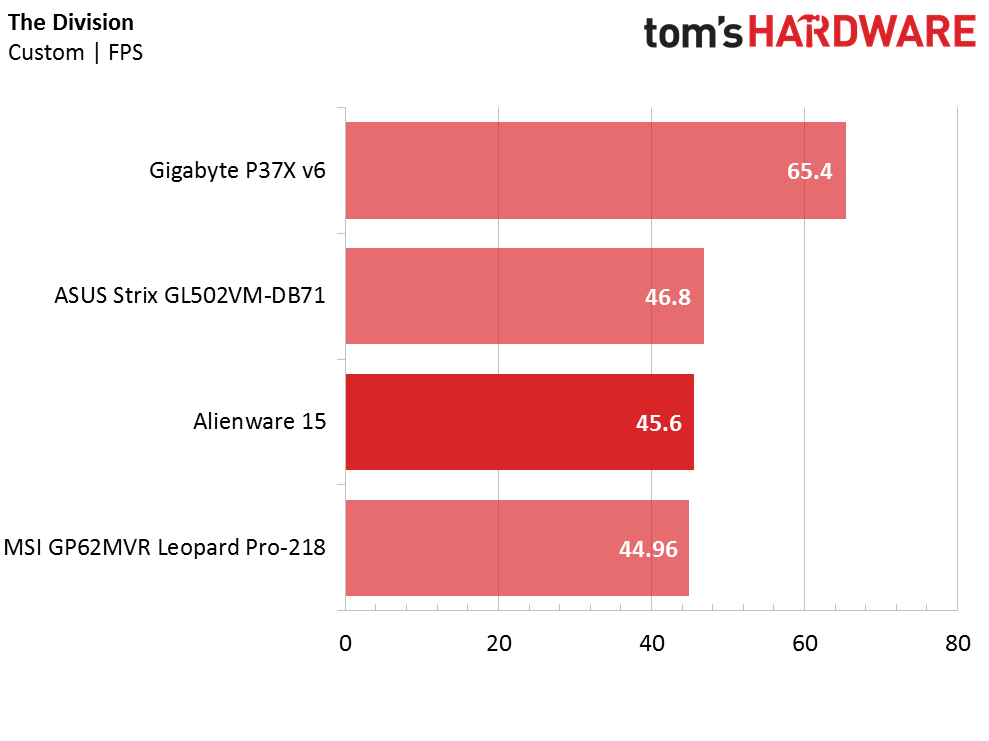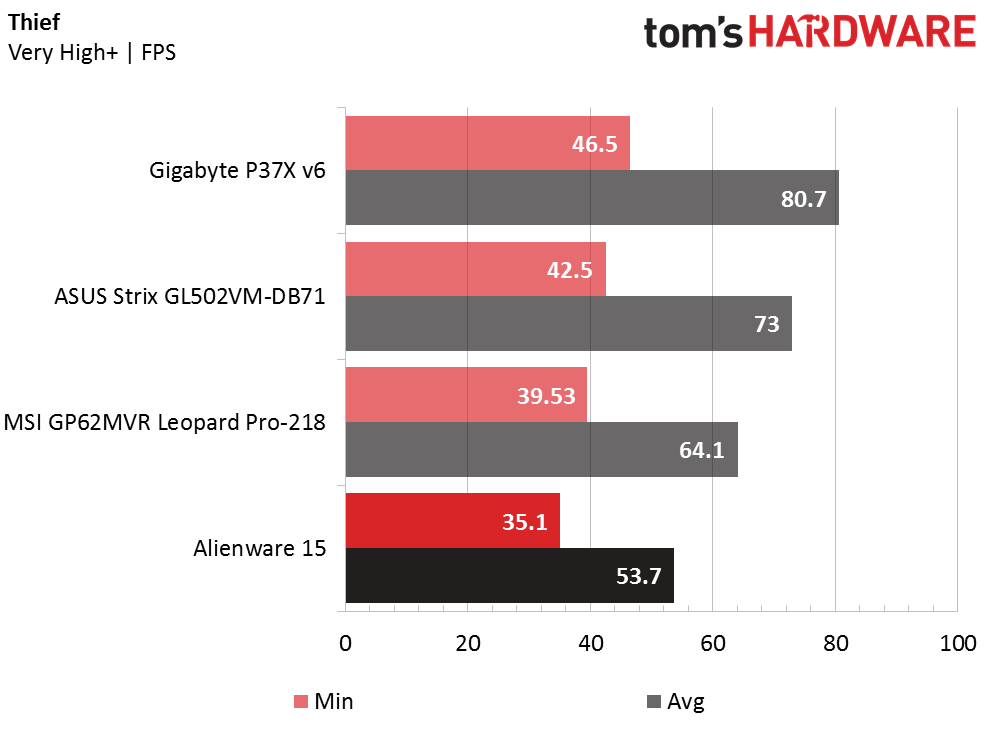Alienware 15 R3 Gaming Laptop Review
Why you can trust Tom's Hardware
Gaming Benchmarks
Alien: Isolation
Alien: Isolation’s demands are primarily GPU-based, and it doesn't require a ton of horsepower at that. Therefore, the Alienware 15 feels right at home (pun intended). Compared to the other GTX 1060 laptops, our Alienware takes the bottom slot, but it's not far behind the competition. With an average of 110.99 FPS, the i5 system is more than sufficient.
Ashes of the Singularity
Ashes of the Singularity is a pretty CPU-intensive game, and one that even systems with i7-6700HQ processors struggle to conquer. Because it's limited by its i5 CPU, the Alienware falls behind the better-equipped configurations. At only 30.8 FPS, the Alienware 15 sees between a 7-15% performance decrease comparatively.
Bioshock Infinite
Similarly, Bioshock Infinite can make some demands of a system's CPU, in addition to its GPU. Both the Leopard Pro and Strix 15 score within the margin of error, given their identical CPU and GPU. The Alienware takes a significant (10-15.61%) performance hit compared against other GTX 1060-equipped laptops. But then Bioshock Infinite isn't exactly the most demanding game.
DiRT Rally
DiRT Rally is more fond of generous GPU frame buffers, and also rewards a strong CPU. As such, the Alienware wins and loses in this battle, but ultimately it outperforms the Leopard Pro, albeit by a fraction, thanks to the Leopard Pro's 3GB GTX 1060 module.
Grand Theft Auto V
Grand Theft Auto V is an incredibly demanding and VRAM-reliant game. The Alienware outperforms the Leopard Pro in all of GTA V's benchmark scenes. That isn't to say a strong CPU wouldn't benefit GTA V performance; the difference isn't great, but the Alienware 15 still falls behind the Asus laptop, which has both an i7-6700HQ and a 6GB GTX 1060.
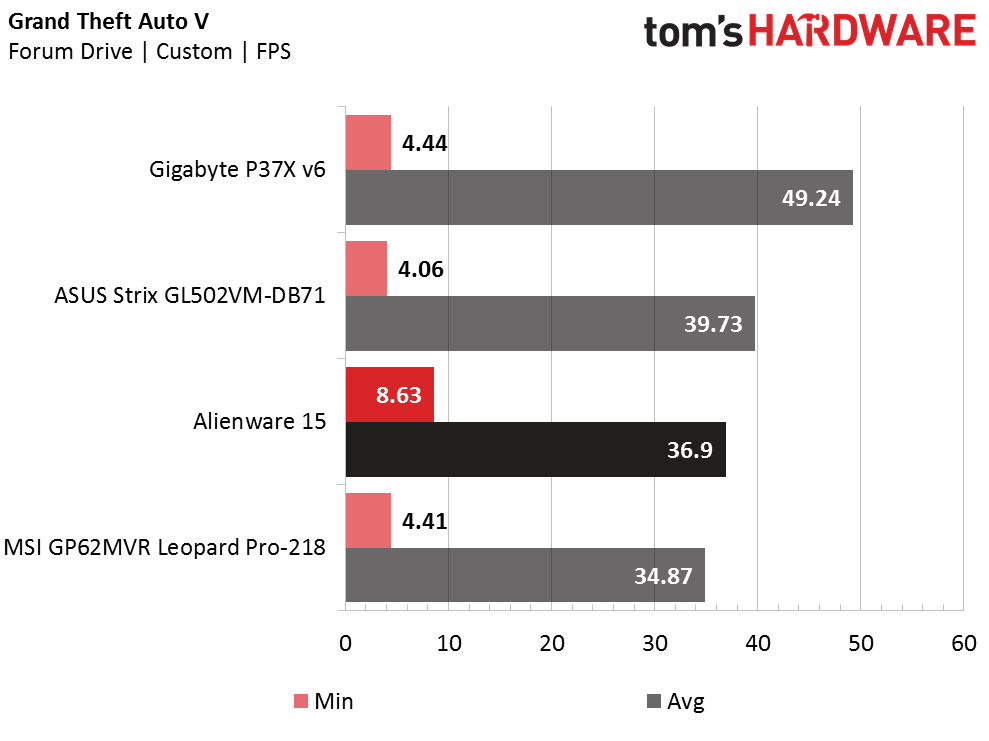
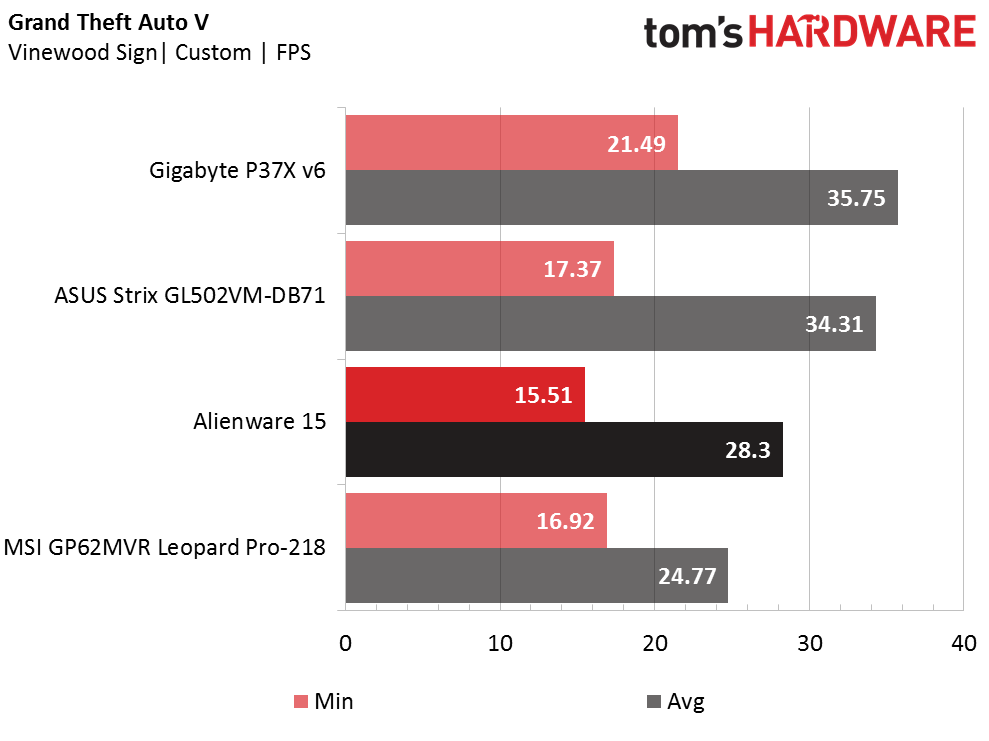
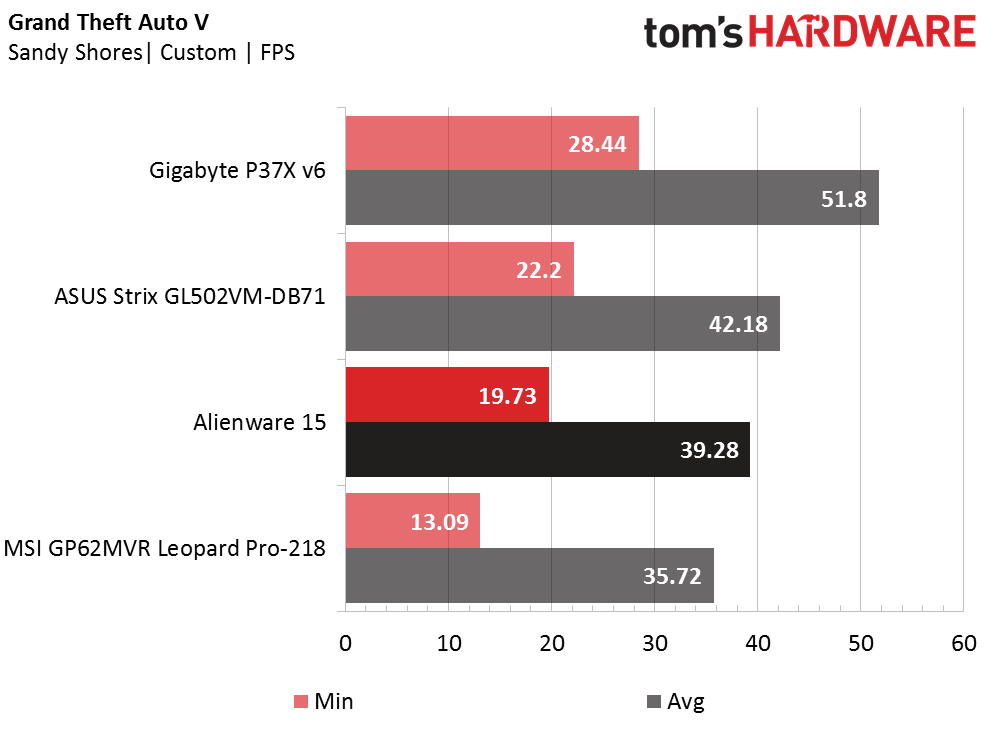
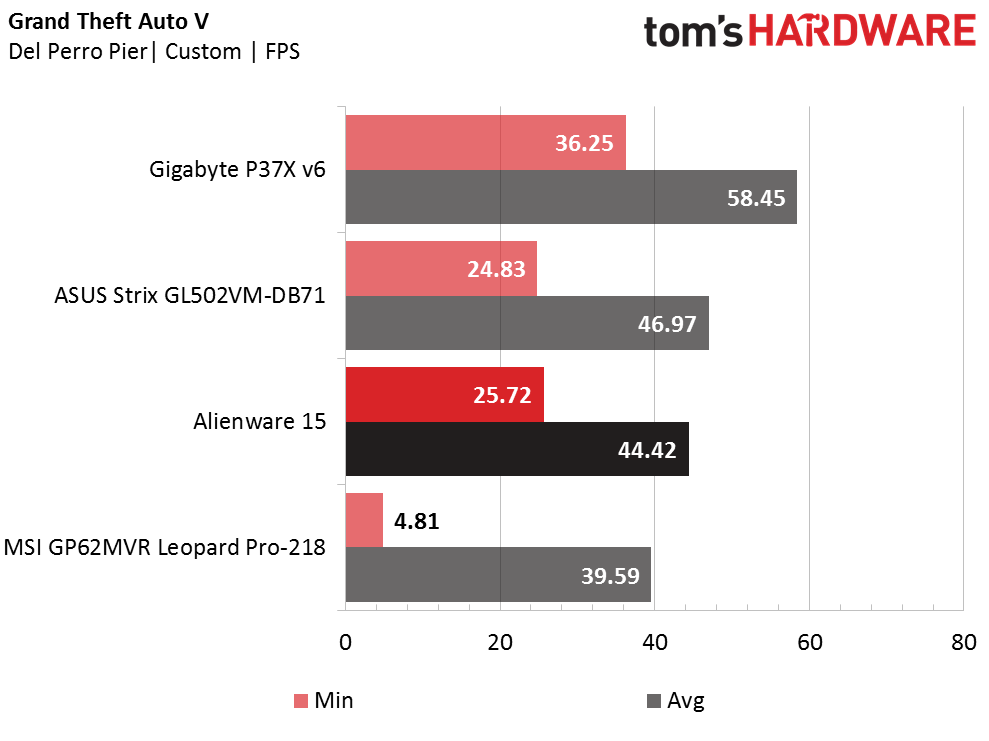

GRID Autosport
GRID Autosport likes a strong overall platform performance, so the Alienware 15 ends up in last place yet again. We witness a whopping 32.1% performance difference compared with the Asus Strix 15, and even a 23.2% performance gap compared with the Leopard Pro, which only has half the Alienware laptop's VRAM.
Hitman
In Hitman, systems will benefit most from having a strong GPU with a sufficient amount of VRAM. But even though the Alienware 15 has a larger 6GB GTX 1060 module compared to the MSI Leopard Pro, its less powerful i5-6300HQ spells its defeat. Both systems perform below 60 FPS, whereas the the Asus Strix 15, which isn't hindered by an i5 or less VRAM, maintains a 61.33 FPS average.
Get Tom's Hardware's best news and in-depth reviews, straight to your inbox.
Metro: Last Light Redux
Metro: Last Light Redux is a heavy-hitter that taxes even the most powerful systems. It comes as no surprise that the least powerful system we’ve tested so far doesn’t fare very well. At best, the Alienware system falls behind the Leopard Pro-218 by 12.7%. It seems like the absolute minimum specifications required to maintain a solid 60 FPS are an i7 and a GTX 1070, so the Alienware's i5 and GTX 1060 just don't make the cut.
Rise of the Tomb Raider
Rise of the Tomb Raider also likes a strong GPU and more VRAM, so the Alienware 15 has a chance to shine over its peers. The Alienware scores 31.31 FPS on average, which is almost 50% better than the MSI Leopard Pro. It also outscores the Strix 15 by a couple of FPS.
The Division
Similarly, The Division benefits from more VRAM, but not to the extent that game performance is hindered like it is in Rise of the Tomb Raider. The Alienware's 6GB GTX 1060 grabs 45.6 FPS on average, which is slightly above the Leopard Pro and just a cut below the Strix 15. It's safe to safe that performance in The Division isn't hindered by the i5-6300HQ.
Thief
The past couple of titles were kind to the Alienware 15 because they favored systems with adequate VRAM, but performance in Thief weighs slightly in favor of platform performance once more. The Alienware scores 53.7 FPS on average, which is about 10% less than the ideal 60 FPS. Even the Leopard Pro is able to achieve above 60 FPS, despite having less VRAM, so we can definitively pin the bottleneck on the Alienware's CPU.
Current page: Gaming Benchmarks
Prev Page Synthetic And Productivity Benchmarks Next Page Battery, Thermal And Display Testing-
ledhead11 "gaming laptop", not quite. Nice case though, obvious where most of the money is going.Reply
I think if a manufacturer commits to 1440p/144khz-gsync/1070/16gb 213mhz w/ an adequate i5/i7 then you'd get a lot of people willing to happily pay around $2000-2300. Pretty sure I read mention of an Aorus model here somewhere. Would love to see a review of that beast.
All these 1080p-60hz/$1400-1800 w/ 1050/1060's are really unimpressive in terms of price/performance. You'd almost be better off getting one of those custom built mobile PS4's. -
nebun for the price the benchmarks are very disappointing....thanks but no thanks.....Alienware is not what it used to be...also bloatware up the arse...i have a 17 R4 model and at times i am very disappointedReply -
lunyone Having only 8 gb's of RAM is disappointing. Could you upgrade to 16 gb's and see if this changes anything in the results? I'm also with LEDHEAD11 about the pricing for laptops with 1080p 60 hz 15" laptops in this price range. I would have liked to see a GTX 1070 in the $1,400-$1,500 price range, but I guess I'm asking for too much. The GTX 1060 should be filling the $800-$1,200 price range, IMHO.Reply -
Clamyboy74 Could you do a review of the clevo p650rp6/ Sager np8151/np8152? I've been scouring the web for a review on those two laptops, with no luck.Reply -
Martell1977 I'm still waiting for the models with the RX 470 in them. These nVidia models are overpriced and out of my price range. Considering you can get a laptop with a 960m for around $800, I had hoped the pricing would have been comparable. I know the performance difference, but that doesn't excuse almost doubling the price. Each new gen comes with performance increases.Reply -
Clamyboy74 The RX470 is an option in the Alienware 15, but it costs just as much as the 1060 configuration.Reply -
Temp__ I don't understand why the reviewer chose the lowest end alienware laptop and then mentioned cpu bottleneck as a con.Reply
If you were going to do such a big detailed review, you should have chosen the model majority of people would like to go with. The one with i7-6700HQ, 16Gigs Ram. And also, this is perhaps the only laptop which I have seen with options to choose battery size. I think you chose the lower battery version, but if you wanted you could have chosen the 99Whr battery for $50 extra and it would have beat all the laptops in the competition. 99Whr is the maximum legal limit for batteries in a laptop! Many other reviewers said that this one has one of the best batteries in its category. 6-8 hours on regular web-browsing in non-gsync version.
Also, there is a 1440p and 4k version including one with 120hz. -
ragenalien Can you please do a normal use battery life test for these? I understand they're for gaming but that's not all people use them for.Reply -
FritzEiv Reply18893424 said:I don't understand why the reviewer chose the lowest end alienware laptop and then mentioned cpu bottleneck as a con.
If you were going to do such a big detailed review, you should have chosen the model majority of people would like to go with. The one with i7-6700HQ, 16Gigs Ram. And also, this is perhaps the only laptop which I have seen with options to choose battery size. I think you chose the lower battery version, but if you wanted you could have chosen the 99Whr battery for $50 extra and it would have beat all the laptops in the competition. 99Whr is the maximum legal limit for batteries in a laptop! Many other reviewers said that this one has one of the best batteries in its category. 6-8 hours on regular web-browsing in non-gsync version.
Also, there is a 1440p and 4k version including one with 120hz.
I don't disagree with you here. We started looking at the sub-$1500 market at the 1060 GPU, and we specifically chose this one (we actually purchased it, because Alienware has been slow to provide us with review hardware) because we wanted to give a starting point range of what was possible under that price point; it wasn't our intention to hobble any particular vendor/product. In our MSI Leopard review, a commenter asked us to look at an i5-based system, in fact. Our intention is to look at a range of configurations at a variety of price points and expand the scope and comparison field, and we've got a few others on the way. I'm also planning to reach back out to Alienware to see if we can get a few more models in.
